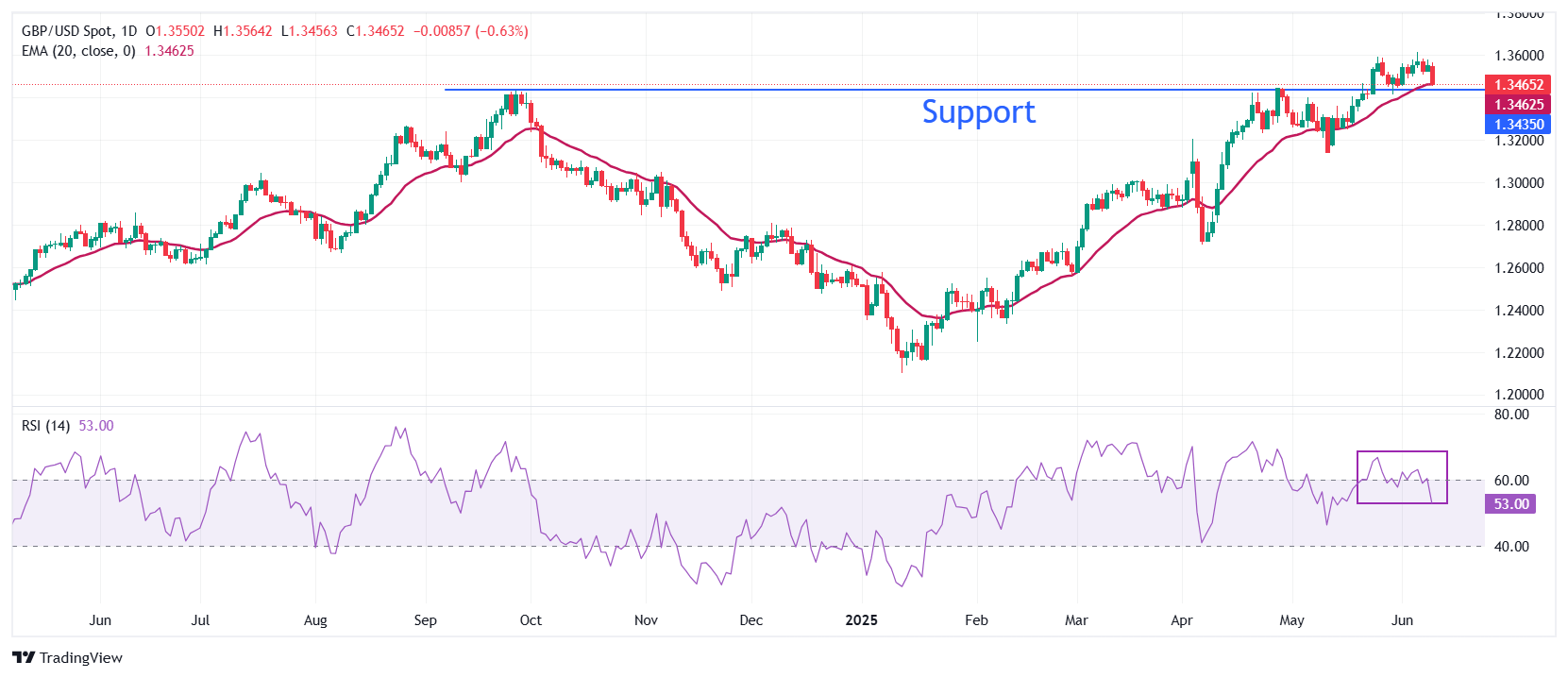Pound Sterling tumbles on weak set of UK employment data
- The Pound Sterling plummets against its major peers after the release of the weak UK labor market data for the three months ending April.
- UK ILO Unemployment Rate accelerated to 4.6%, the highest level seen since July 2021.
- Investors seek Sino-US trade meeting minutes for fresh cues on the US Dollar’s outlook.
The Pound Sterling (GBP) faces a sharp selling pressure against its peers on Tuesday after the United Kingdom (UK) Office for National Statistics (ONS) reported that the labor market cooled down in three months ending April.
The data showed that the economy added 89K fresh workers, fewer than 112K seen in the quarter ending March. The ILO Unemployment Rate accelerated to 4.6%, as expected, from the prior release of 4.5%. This is the highest level in the jobless rate seen since July 2021. Slowing UK job growth reflects the impact of the increase in employers’ contributions to social security schemes.
UK Chancellor of the Exchequer Rachel Reeves raised employers’ contribution to National Insurance (NI) from 13.8% to 15% in the Autumn Statement, which became effective in April.
Meanwhile, Average Earnings, a key measure of wage growth that drives inflation in the services sector, has grown at a modest pace. Average Earnings Excluding Bonuses rose by 5.2%, slower than estimates of 5.4% and the prior reading of 5.5%, revised lower from 5.6%. The wage growth measure including bonuses grew at a slower pace of 5.3%, compared to expectations of 5.5% and the previous release of 5.6%, revised higher from 5.5%.
Slower wage growth and a slowdown in the labor demand are expected to encourage Bank of England (BoE) officials to reassess their guidance that the central bank will follow a “gradual and cautious” monetary expansion approach, which they delivered in May after lowering interest rates by 25 basis points (bps) to 4.25%.
Meanwhile, traders are confident that the BoE will keep interest rates steady at 4.25% in the policy meeting on June 19.
This week, investors should brace for more volatility in the British currency as the monthly Gross Domestic Product (GDP) and factory data for April are scheduled for release on Thursday.
Daily digest market movers: Pound Sterling falls sharply against US Dollar amid US-China trade talks
- The Pound Sterling slumps to near 1.3456 against the US Dollar (USD) during European trading hours on Tuesday. The US Dollar trades calmly against its major peers, with investors awaiting the outcome of trade discussions between the United States (US) and China, which started on Monday. The US Dollar Index (DXY), which tracks the Greenback’s value against six major currencies, ticks up to near 99.00.
- The US Dollar had a strong run-up before the Sino-US trade talks in Geneva a few weeks ago. Investors seem to be hesitant to buy on optimism this time as they want concrete trade terms. "A deal to keep talking might be better than nothing, but unless we see a concrete breakthrough, the impact on sentiment is likely to remain muted,” analysts at Saxo Markets said Reuters reported.
- Meanwhile, the White House has expressed confidence that a breakthrough outcome will be achieved after the US-China trade meeting. US National Economic Adviser Kevin Hassett stated in an interview with CNBC on Monday that “export controls to be eased and rare earths to be released in volume” after the meeting.
- On the economic calendar front, investors await the US Consumer Price Index (CPI) data for May, which will be released on Wednesday. The CPI report is expected to show that the headline inflation rose at a faster pace of 2.5% on year, compared to a 2.3% growth seen in April. In the same period, the core CPI, which excludes volatile food and energy prices, is anticipated to accelerate to 2.9% from the prior reading of 2.8%. These inflation figures are likely to influence market expectations for the Federal Reserve’s (Fed) monetary policy outlook.
- According to the CME FedWatch tool, the US central bank is unlikely to cut interest rates before the September monetary policy meeting.
Technical Analysis: Pound Sterling corrects to near 20-day EMA

The Pound Sterling slips to near 1.3456 against the US Dollar on Tuesday after failing to revisit the three-year high of 1.3617. The outlook for the pair has become uncertain as it has declined to near the 20-Day Exponential Moving Average (EMA), which oscillates around 1.3467.
The 14-day Relative Strength Index (RSI) faces pressure near 60.00, indicating that the upside is capped.
On the upside, the 13 January 2022 high of 1.3750 will be a key hurdle for the pair. Looking down, the horizontal line plotted from the 26 September 2024 high of 1.3434 will act as a key support zone.
Pound Sterling FAQs
The Pound Sterling (GBP) is the oldest currency in the world (886 AD) and the official currency of the United Kingdom. It is the fourth most traded unit for foreign exchange (FX) in the world, accounting for 12% of all transactions, averaging $630 billion a day, according to 2022 data. Its key trading pairs are GBP/USD, also known as ‘Cable’, which accounts for 11% of FX, GBP/JPY, or the ‘Dragon’ as it is known by traders (3%), and EUR/GBP (2%). The Pound Sterling is issued by the Bank of England (BoE).
The single most important factor influencing the value of the Pound Sterling is monetary policy decided by the Bank of England. The BoE bases its decisions on whether it has achieved its primary goal of “price stability” – a steady inflation rate of around 2%. Its primary tool for achieving this is the adjustment of interest rates. When inflation is too high, the BoE will try to rein it in by raising interest rates, making it more expensive for people and businesses to access credit. This is generally positive for GBP, as higher interest rates make the UK a more attractive place for global investors to park their money. When inflation falls too low it is a sign economic growth is slowing. In this scenario, the BoE will consider lowering interest rates to cheapen credit so businesses will borrow more to invest in growth-generating projects.
Data releases gauge the health of the economy and can impact the value of the Pound Sterling. Indicators such as GDP, Manufacturing and Services PMIs, and employment can all influence the direction of the GBP. A strong economy is good for Sterling. Not only does it attract more foreign investment but it may encourage the BoE to put up interest rates, which will directly strengthen GBP. Otherwise, if economic data is weak, the Pound Sterling is likely to fall.
Another significant data release for the Pound Sterling is the Trade Balance. This indicator measures the difference between what a country earns from its exports and what it spends on imports over a given period. If a country produces highly sought-after exports, its currency will benefit purely from the extra demand created from foreign buyers seeking to purchase these goods. Therefore, a positive net Trade Balance strengthens a currency and vice versa for a negative balance.

